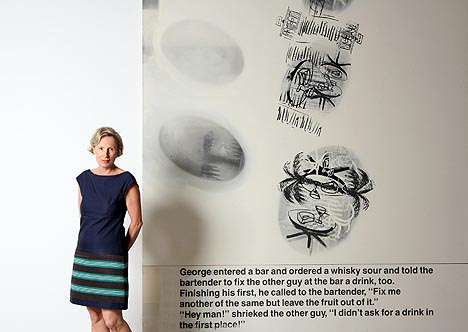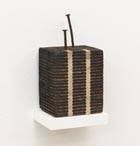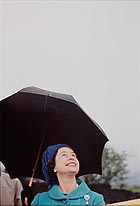
translated and summarized by: Liz Wollner-Grandville,
English summaries September 5 - 18
MUMOK Museum moderner Kunst
Museum of Desires
10.09.11 - 08.01.12
The first shot was a hit
Last year, when Karola Kraus became the new director of the MUMOK, she immediately announced the closure of the house for several months in order for renovations to be undertaken. With the first exhibition, she was subject to immense expectations: if you close down, then something really wonderful has to be presented afterwards.
Kraus didn't dedicate the prelude to her time in Vienna to arbitrary artists, a world-wide theme or some sort of private collection, but rather to the collection of the house itself – and that which, in her opinion and in that of the curator team, was missing.
The "Museum of Desires" is not quite such a new idea, as Kraus herself immediately admitted, but rather it leans on a concept by Kasper König and before that, Pontus Hultén: works from the collection presented together with those that the museum wishes.
The collection presents itself in a seemingly confused turmoil on six floors – strict historic art dividing lines are overstepped, unexpected coherencies can be detected: the top floor convinces with a particularly elaborate hanging in which the avant-garde classicists are intelligently complemented by younger works: Maria Lassnig is to be found beside Francis Picabia, Lucio Fontana beside Paul Klee. Henryk Stazewski's relief – a wish – appears next to a work by Robert Delaunay and a mobile by Alexander Calder virtually like a synthesis from these two works. A further curator-like highlight is to be found one floor down in that room which positions the linear discreetly as well as consequently into the centre: the mobiles by Karel Malich, the paintings by Zdenek Sykore and the small paper works by Raoul Hausmann complement each other as if they were old friends; Fred Sandback's subtle tension reacts to Carl Andres' floor work and Imi Knoebl's diptych (wish!).
Hangings that are a little less obscure can be found on the lower floors where Stephen Prina – also a wish – is jointly presented with Christopher Williams, and Tom Burr with Henrik Olesen. One can't deduce quite why.
All the same: the MUMOK's collection was never so refreshingly and unconventionally arranged. This can be attributed to the fact that the works of some artists – such as Louise Lawler or Sol LeWitt – are to be found in completely different contexts. Karola Kraus really has scored a hit with the first shot.
By Nina Schedlmayer
MUMOK Museum moderner Kunst
1070 Vienna, MuseumsQuartier, Museumsplatz 1
Tel: +43 1 52 500
Fax: +43 1 52 500 13 00
Email: info@mumok.at
www.mumok.at
Opening hours: Daily 10 a.m. – 6 p.m., Thu 10 a.m. – 9 p.m.
Museo Thyssen-Bornemisza
Antonio López
28.06.11 - 25.09.11
Spanish Insiders’ Tip
Is Antonio López an insiders’ tip? The painter has long been known to the friends of the Mancha, quinces and the city of Madrid. Colossal city views in a misty light, the deserted Gran Via at the crack of dawn, the dusty main street of the village Tomelloso in the Ciudad Real Province. The view of "Madrid desde Torres Blancas" (1974-1982) was this year's eye-catcher in the Galería Marlborough at the Arco Art Fair. Record auction prices catapulted the master to first place in Spanish contemporaries in front of the eternal young talent of Miquel Barceló and old master Antoni Tàpies.
The fact that, in spite of these successes, there are not too many experts outside Spain who know Antonio López (born 1936) lies perhaps in his very Spanish subjects even though several of the pictures on loan do indeed come from German museums and now, it's thanks to the Thyssen-Bornemisza Museum that has opened its doors to the painter and sculptor. A show was presented in Boston in 2008 but 18 years have passed since the last large exhibition in Spain's Reina Sofía Museum.
Productive years with a plethora of works. Drawings, pictures, sculptures in bronze – 140 works. Over-dimensional busts and heads are scattered about the city of Madrid and its suburbs; hordes of models fill entire display cabinets in the museum. Master models are those of the artist's two daughters and the younger one, María, has curated the exhibition together with the museum's director, Guillermo Solana. As a childish plaster figure, she stretches out her arms in an expression of astonishment and veneration: "María, standing, 1963".
Antonio López is a quaint realist who is not concerned with photographic precision but rather with the real mood. He worked for years on one picture in order to capture the slanting rays of the morning sun in August. Always in August, always at dawn. That led to pictures that opened up a new dimension to the onlooker: one almost hears the excited squeaks of the whirring swifts flying freely through the sleepy morning freshness before the blazing heat spreads over the metropolis.
The smell of neglect and dust lies over other monumental pictures such as derelict baths or rooms, demolition subjects with old tiles – documentation of a disappearing Madrid. He paints on the spot, stands in the light, accepts the glances of curious passers-by. His uncle, the painter Antonio López Torres, encouraged his talent early on. In Madrid, he founded the Escuela de Madrid together with Lucio Muñóz, Amalia Avia and Enrique Gran. He is married to the painter María Moreno.
As a sculptor, he forms people; as a painter, he doesn't. Apart from exceptions – in Atocha 1964, a naked couple are lying entwined in the foreground, his parents, the large drawing of a recumbent woman on the strand – the unpeopled stony desert, deserted, yes inhuman with a dirty sky, billowing smoke and the vastness of the Mancha which the agglomeration of concrete and glass only makes more unnatural. Alienated reality beneath the heat.
Contrary to the anonymity of the city is the intimacy of the pastoral province: the inner courtyard, the trees, the quinces or also the roses in a vase. The exhibition doesn't run chronologically or thematically but places a workshop character on its mixture of epochs and subjects, drawings, sculptures and pictures. Two video films are also on show with commentaries by contemporaries and, in their own effective shy and modest descriptions, above all convey to us that all this man wants is work, work, work.
By Clementine Kügler
Museo Thyssen-Bornemisza
28014 Madrid, Palacio de Villahermosa Paseo del Prado, 8
Tel: +34 91 369 01 51
Fax: +34 91 420 27 80
Email: mtb@museothyssen.org
www.museothyssen.org
Galerie Lindner
Roger Ackling - Light Works
08.09.11 - 14.10.11
Blackened Flotsam
The Galerie Lindner opens its autumn art season with works by the British artist, Roger Ackling.
The 65-year old artist, who lives near the Norfolk coast, gets inspiration for his works from the surrounding nature. On long walks along the strand, he searches for objects washed up by the ocean – driftwood furnished with holes and nails which has been smoothed down by water and rubbed down by sand. After he has dried it, he uses a lens and sunlight to burn black dotted lines into the wood, which decorate the object like a string of pearls. Sometimes he enhances his object with halved clothes pegs that are blackened by the sun and mounted by means of a cord.
Archaic artefacts reminiscent of totem poles are created through the flotsam being burnt by the sunlight. Associations with schamanistic art as well as with aboriginal art are awakened. One can also ascertain a connection to European arte povera as mentioned by Wolfgang Zinggl in his opening speech. Arte povera is also associated with materials found – objets trouvés – which are espoused to a certain sparseness and which can be changed by external influences such as sand and wind.
Ackling's works are particularly remarkable by the absence of artificial-mechanical intervention – it's only the sun and the sea and a hardly-noticeable human hand that creates here.
Together with Hamish Fulton, Ackling became well known through the course of Land Art and Environmental Art. But Ackling left the all too processual, volatile art behind and developed a reduced, "ever-lasting" object that, for purposes of an exhibition, could be packed quickly into a suitcase, together with other pieces. The artist travels lightly in the same way as a Greek philosopher who can always carry his "utensils of thought" with him. On that note, we wish Roger Ackling's exhibition many visitors.
By Susanne Rohringer
Galerie Lindner
1060 Vienna, Schmalzhofgasse 13/3
Tel: 01/913 44 58
Fax: 01/913 44 58
E-mail: Galerie.Lindner@chello.at
www.galerie-lindner.at
Opening hours: Wed-Fri 2 pm – 6 pm., Sat 11 am – 1 pm
Scottish National Portrait Gallery
The Queen: Art & Image
25.06.11 - 18.09.11
Keep smiling, Queenie
One of the best epochs in the history of England will unfurl itself under the scepter of a female monarch, Winston Churchill announced joyfully in his radio speech – a tribute dedicated to the recently deceased King George VI. George - who has since become well known through "The King's Speech" which portrays his massive speech problem, and who had accompanied his peoples through the war years – was dead, and Churchill's speech ended with a sequacious "God save the Queen". And the established form has not changed for almost six decades.
In Great Britain, more than in any other country, the tradition of portraits is still upheld. Year in, year out in the National Portrait Gallery, one can track which representatives of politics, science, (pop)culture, and also the nobility are found to be currently so noteworthy that their likenesses are perpetuated in arbitrary media and they find their way into the national collection. True to the mission of the institution, the exhibitions of the house on this theme count as the most profound.
On the occasion of the diamond jubilee of the Queen's accession to the throne, the National Portrait Gallery has now put together an exhibition which, with the aid of official painted and photographic portraits, pictures from the media and the likeness of the Queen as the image and icon of modern art, passes the revue of decades: one person, 60 years and all sorts of traditions, conventions and their declnes which now and again turn out to be provocation for the royal household and its faithful servants. Jamie Reid's design for the cover of the single "God Save The Queen" by the Sex Pistols, "Medusa" by Hew Locke who fills out the unmistakable contours of the monarch with all sorts of plastic kitsch and colourful strings of pearls, or Lucian Freud's pitiless and grotesque portrait was highly controversially received by the public. The one portrayed seemed to rise above it. And what would be appropriate for the genre of a sovereign portrait? Is a crown necessary? Or the admiral's cloak which Pietro Annigoni, Cecil Beaton or Annie Leibovitz, have, over the decades, thrown over the monarch's shoulder?
To rule, to represent but also to correct the image: the British royal house knows how to handle the power of the pictures. Precisely when the sympathies in the country following Diana's death threatened to completely overturn everything, the Queen showed herself to be down-to-earth. And the exhibition doesn't omit this aspect.
The Britons were taken aback when the German Thomas Sturth was assigned to paint the official jubilee portrait. The result will be exhibited for the first time in the exhibition and one is just as "amused" as the Queen and her husband. And thus one can say: it still exists - the contemporary portrayal.
By Daniela Gregori
Scottish National Portrait Gallery
EH2 1JD Edinburgh, 1 Queen Street
Tel: +44 (0)131 624 6336
www.nationalgalleries.org
Opening hours: daily 10 am – 5 pm, Thu 10 am – 7 pm
Further exhibition locations:
Ulster Museum, Belfast 14 October 2011 to 15 January 2012
National Museum Cardiff 04 February 2012 to 29 April 2012
National Portrait Gallery, London 17 May 2012 to 21 October 2012
Mehr Texte von translated and summarized by: Liz Wollner-Grandville


 Teilen
Teilen




